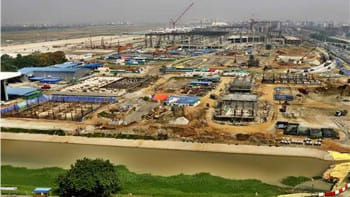Take steps to ensure smooth take-off of the third terminal

Amid persistent economic struggles as well as efforts to remove barriers deterring businesses from investing and expanding in the country, there is no alternative to ensuring a smooth take-off of the much-anticipated third terminal of the Hazrat Shahjalal International Airport in Dhaka. Built at a cost of over Tk 21,300 crore, the terminal is being touted as a milestone for Bangladesh's aviation sector, with the planning adviser recently underscoring its potential to make the airport a regional hub. For this promise to materialise, we must ensure the project doesn't falter on operational readiness, particularly with regard to customs and cargo handling.
With over 99.5 percent of the construction work already completed, the terminal is technically close to the finish line. However, a recent letter from the Customs House Dhaka to the Civil Aviation Authority of Bangladesh (CAAB) has raised concerns about a number of issues related to its infrastructure, security, and operational aspects, according to a report by this daily. For example, a key concern raised by the inspectors involves the customs hall, which they say is too narrow with a low ceiling and a capacity of only 300, despite an expected influx of 7,000 to 8,000 passengers at peak hours. This may result in heavy congestion, slow clearance, and poor ventilation. After the terminal's full-scale opening, expected in early 2026, it is estimated that the annual passenger handling capacity of the airport will rise to 2.4 crore from 80 lakh at present.
A key concern raised by the inspectors involves the customs hall, which they say is too narrow with a low ceiling and a capacity of only 300, despite an expected influx of 7,000 to 8,000 passengers at peak hours. This may result in heavy congestion, slow clearance, and poor ventilation. After the terminal's full-scale opening, expected in early 2026, it is estimated that the annual passenger handling capacity of the airport will rise to 2.4 crore from 80 lakh at present.
Customs officials have also flagged several issues related to cargo handling. Among them is the lack of designated warehousing for seized or high-value goods, which poses risks of theft, misuse, and smuggling. The placement of the duty-free shop immediately after immigration, without adequate surveillance or access control, also risks revenue leakage. Moreover, the lack of designated space for scanners, physical examination of baggage and consignments, and diversion routes for high-risk baggage may emerge as another big problem, especially given the expected doubling of cargo throughput once the terminal goes live. These and other such inadequacies could further contribute to security risks, unnecessary delays, and even tax evasion.
While acknowledging these shortcomings, the relevant authorities have said that it is not possible to alter the existing infrastructure now, so they are focusing on workarounds as alternative solutions. But the need for resolving these issues cannot be stressed enough either, especially for the sake of a safe, uninterrupted operation of the terminal. We, therefore, urge the authorities to seriously consider the recommendations given by customs inspectors and find ways to implement them.


 For all latest news, follow The Daily Star's Google News channel.
For all latest news, follow The Daily Star's Google News channel. 









Comments